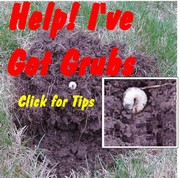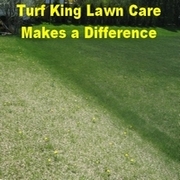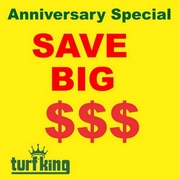Grubs are starting to be found in lawns by late August. If the lawn has been brown or dead since July, it is more likely to have been caused by chinch bugs.
People first notice a problem in one of two ways.
- Animals digging in the lawn
- Dead or dying patches of lawn
The digging by animals is a problem. Most likely there are grubs there. There are no insecticides currently allowed for the treatment of grubs. Nematodes can be used in warm weather (mid Aug to mid Oct). One problem with nematodes is that they may only control 50-75% of the grubs (if we are lucky). Also it does take time for the grubs to die therefore, sometimes, the skunks and/or raccoons may still come for dying grubs or for the ones that were not controlled.
To look on the bright side, the animals digging for grubs are at least getting rid of some grubs. If you could train them to put the sod back after they are finished, we could hire them!
Nematodes should be applied as early as possible. Smaller grubs are easier to control than larger grubs. The more the grubs feed on your lawn, the larger they become and harder to eliminate. Plus more damage is done to the lawn.
CALL NOW to order a NEMATODE Treatment 905-318-6677
What else should be done?
- Feed the lawn to help any surviving lawn to recover and to fill in the damage.Good quality fertilizer is important to help the lawn fill the spaces where the roots have been eaten by the grubs
- Keep an eye on moisture levels. Since grubs feed on the roots, the lawn will be under stress. When there is a lot of rainfall, the damage is less severe.
- Repair any damage by seeding. See seeding options below.
- Consider applying nematodes next season to prevent as much damage as possible.
Shall I do a treatment next spring?
The grubs do survive the winter. The animals may be back next spring, but I would not recommend treating at that time. Nematodes could technically be used in the spring once the soil warms up. Even when chemical insecticides were available, I normally did not recommend treating for grubs in the spring.
The grubs do survive the winter. The animals may be back next spring, but I would not recommend treating at that time. Nematodes could technically be used in the spring once the soil warms up. Even when chemical insecticides were available, I normally did not recommend treating for grubs in the spring.
Reasons for not treating.
1. Most of the damage to the lawn by the grub is done in the fall. Some feeding does occur, but generally it is minimal.
2. Spring grubs have now reached close to their maximum size and are harder to kill with insecticides.
3. Even if they could be controlled, the grubs in your lawn are not necessarily the source of the next batch of grubs to invade your lawn. (grubs pupate in May-June, then emerge as adults in June-July. The adults can fly. This means they can go to other lawns to lay their eggs that then hatch into baby grubs.) So even if we got rid of all the grubs in your lawn, adults from down the road, across the street or from a neighbourhood park, may still fly over to your lawn and lay eggs in the soil. Controlling the grubs in your lawn in the spring will mean fewer adults flying in your neighbourhood, but not necessarily any fewer eggs laid on YOUR lawn.
What should you do when animals are digging?
Once the animals have stopped coming to your lawn, replace the sod pieces as best you can (green side up). Don't do it every morning, because most likely they will come back and rip up the same piece tomorrow night.
If it is cool and damp and the sod, if it is still alive, will survive a few days on its back. If it is hot and dry, put a sprinkler on the disturbed lawn. By waiting you will be less frustrated - hopefully you replace the sod only once or twice.
There are animal repellers that usually work to keep the animals away. Contact us for more information.
How to Repair Damage
If the damage is very minimal, sometimes a couple of pieces of sod, may provide an easier fix. Do this if sod is available
There are several ways to seed your lawn to repair insect damage
One way is to add some soil as needed, and sprinkle lots of good quality grass seed that is appropriate for the sun/shade conditions of your lawn. If it is both sunny and shady, and you only want to purchase one type of seed, use shady grass seed. Shady grass seed will grow better in the sun than sunny grass will in the shade.
If the damage is very severe, the easiest way to get grass back is to aerate and overseed. Seeds falling in the aeration holes are protected from drying out, and from the birds.
If you have a lawn/tree/shrub that needs some Tender Loving Care- get The KING OF GREEN:
or call us at 905.318.6677 or 1.888.TURFKING (887.3546)
If you would like more information, please Contact us
Follow us on Twitter http://twitter.com/turfkingofgreen
Copyright 2012 Turf King-Hamilton. All Rights Reserved.











